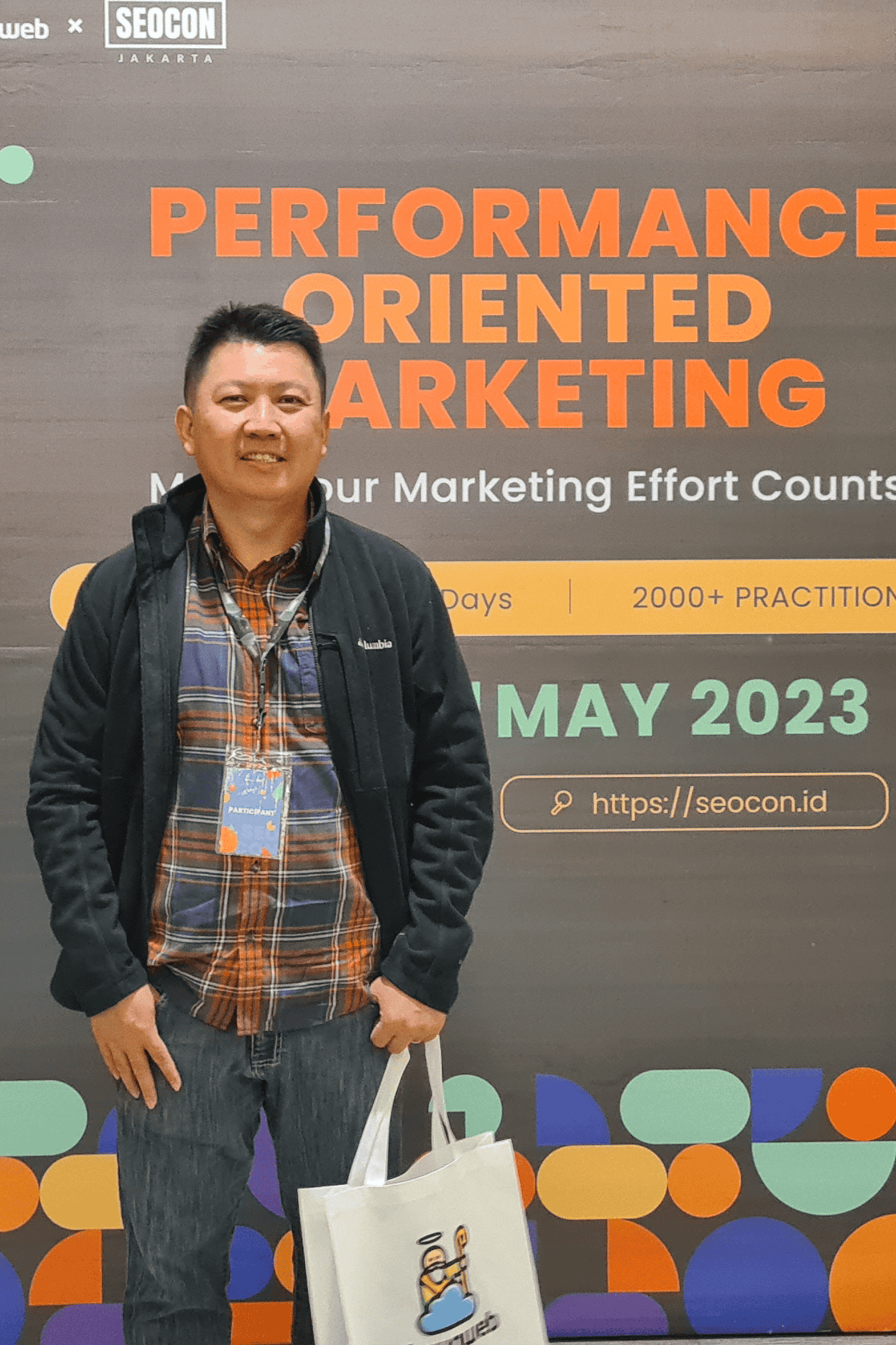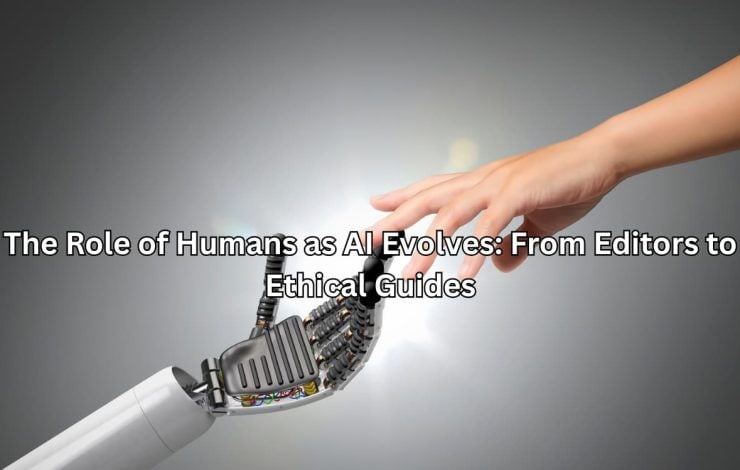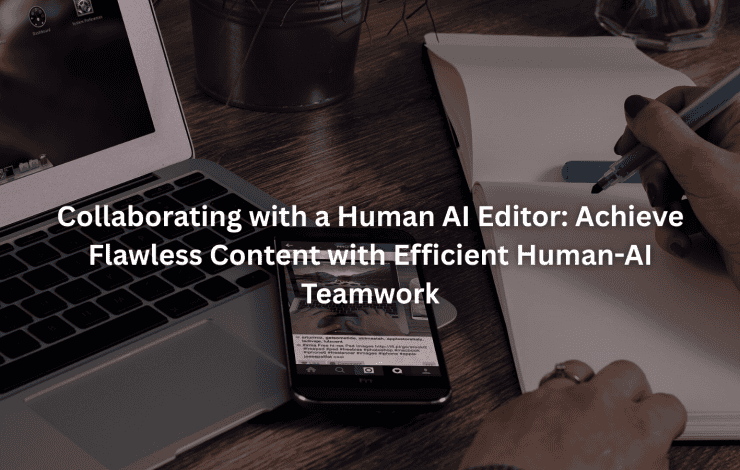The buzz of keyboards fills the modern newsroom, but something’s different now. Between the coffee mugs and style guides, AI writing tools hum alongside human editors. After watching dozens of agencies try and fail to merge the two, there’s finally a clear path forward. The secret? Don’t let the robots run wild.
Key Takeaway
- Mix AI speed with human smarts – it’s not rocket science
- Set real boundaries and double-check everything
- Train your people, track what works, scale carefully
Best Practices for Human AI Editing
The team at Jet Digital Pro stumbled onto something that works. No fancy algorithms, just common sense rules that keep content flowing and mistakes rare.
First up, give AI clear instructions. Write down what you want – tone, style, absolute no-gos. Keep a running list of phrases that make your skin crawl. Then layer the reviews: quick scan for obvious errors, deep dive for the subtle stuff.
Be straight with clients about using AI. Nobody likes finding out later. And keep notes on what works and fails, so next time’s prompts get better.
Quick checklist to steal:
- Write down your rules and banned words
- Human eyes on every piece
- Track AI’s weird habits
- Let robots handle the boring stuff
Collaborating with Human AI Editors
At Jet Digital Pro, editors don’t just pass files back and forth with AI – they leave notes, flag patterns, sometimes laugh at the weird stuff it spits out.
Ground rules matter though. AI drafts first, humans clean it up, senior editors get final say. Everyone works in the same system, tracking changes. Weekly check-ins catch problems before they spread.
Just last month, an editor caught AI mixing up feet and meters across 20 articles. One note in the feedback doc fixed it for good. [1]
Smart moves for your team:
- Use one system to track changes
- Meet regularly about AI quirks
- Fact-check everything
- Share wins and fails
Efficient Human AI Editor Process
A process isn’t worth much if it takes longer than doing things by hand. Efficiency is the main draw of AI, but only if you use it wisely.
Step one: optimize your prompts. A vague prompt gets vague output. At Jet Digital Pro, we stress-test prompts with real client keywords (think: “ethical link building for SaaS,” not just “link building”). This saves time downstream.
Workflow automation is next. AI outputs drop straight into our CMS, ready for editor review. We batch similar articles, so editors spot trends and fix mistakes in clumps instead of one by one. Version control? Always. Our editors can always pull up the original AI file if a fact is questioned later.
Best practices you might steal:
- Batch similar outputs for fast, pattern-based editing.
- Use CMS integration, so AI drafts flow to editors automatically.
- Keep both AI and human-edited versions for auditing.
- Track turnaround times and error rates to spot bottlenecks.
How to Use Human AI Editor
You don’t need a computer science degree to use an AI editor. But you do need a plan. At Jet Digital Pro, the usual flow looks like this:
- The AI generates a first draft from a detailed outline and keyword list.
- A human editor checks for clarity, accuracy, and alignment with the agency’s brand voice.
- Facts are double-checked. No exceptions.
- Final copy gets a once-over for subtle things, awkward phrasing, cultural missteps, tone inconsistencies.
Settings matter, too. For some clients, we dial the AI’s “creativity” way down, keeping it dry and factual. For others, we let it riff a bit, knowing a human will reign in the excesses.
Practical checklist:
- Always start with a project brief (audience, goals, keywords, tone).
- Set the AI’s parameters: length, complexity, style.
- Assign a human to review every draft.
- Require a final sign-off before publishing.
Human AI Editor Workflow Integration

Plugging AI into your workflow shouldn’t mean ripping out everything you’ve built. The best integrations are almost invisible.
At Jet Digital Pro, we embed AI tools within our CMS. Content moves through a stage-gated process: AI writes, human edits, QA checks, then approval. Each step has a clear owner and a checklist. If a draft fails at any stage (say, a fact is wrong or the tone is off), it cycles back for revision.
Quality assurance is the safety net. Our editors use custom checklists to catch lingering errors, especially things AI misses, like context or nuance. For agencies building similar systems, the AI content editor model demonstrated at Jet Digital Pro shows how structured handoffs and stage gating keep quality high without slowing output.
To make this work:
- Use software that allows seamless handoffs between AI and humans.
- Build in checkpoints for fact-checking and style review.
- Make QA a separate step, not an afterthought.
- Keep the process visible so everyone knows their role.
Human in the Loop AI Content
Some call it “human-in-the-loop.” We just call it common sense. AI is great at scale and speed, but it’s clumsy with nuance, judgment, and ethics.
At Jet Digital Pro, every piece of content passes through human hands before it goes live. That’s our insurance policy against bias, hallucination, or accidental plagiarism. In regulated industries, finance, healthcare, law, this is non-negotiable.
Benefits are obvious:
- Faster content production, but with human oversight.
- Fewer embarrassing errors or tone-deaf moments.
- Content that meets both compliance and creative standards.
The best part? Human feedback now trains the AI, making it a little smarter each week.
Managing Human AI Editor Projects
Managing AI-human projects is a balancing act. Too many checkpoints, and you lose speed. Too few, and quality slips.
At Jet Digital Pro, we map out every project with deadlines for both AI drafts and human edits. We track output quality, editor workload, and how often the AI needs corrections. If something goes wrong, like the AI missing a new Google guideline, backup editors jump in.
We also keep leadership updated with a mix of hard data (turnaround times, error rates) and stories from the editing trenches. This helps justify the tech investment and keeps the team motivated.
Project management pointers:
- Break projects into AI and human phases, with clear deadlines.
- Monitor workload to avoid burnout.
- Have backup plans for AI hiccups, like alternate editors or rerouting content.
- Communicate openly with stakeholders about what’s working and what’s not.
Scaling Content with Human AI Editors
Agencies want scale. That’s the point. But scale without systems is chaos.
At Jet Digital Pro, we run several AI writing streams at once. Editors specialize, some focus on blog posts, others on technical SEO copy. We use templates for recurring topics, so prompts stay consistent.
Data is our friend. We watch how long each step takes, where the errors show up, and which editors need more support. If something slows down (like a new content type), we adjust the workflow or add training.
How to scale without breaking things:
- Run parallel AI processes, then batch content for review.
- Specialize human editors by content type.
- Standardize prompts and templates for repeatable tasks.
- Use analytics to spot and fix bottlenecks.
Team Workflow with Human AI Editor
Getting a team to work with AI means more than just teaching tech. It’s about trust, clarity, and the right tools.
At Jet Digital Pro, all content runs through one platform, submissions, edits, approvals. Editors can see AI drafts, leave comments, and tag each other for quick reviews. Handoffs are tracked, so nothing falls through the cracks.
We also track performance. Not to punish, but to see if AI is actually helping. If productivity drops, we tweak the process or offer more training. [2]
Team workflow tips:
- Use one centralized tool for all content tasks.
- Allow real-time collaboration and comment threads.
- Define handoffs clearly: who does what, and when.
- Watch metrics for both speed and quality.
Training Team on Human AI Editing

Are You a Digital Agency?
White Label SEO Content Services for Agencies
Scalable, customizable, and results-driven content solutions for your clients.
Training might be the most underrated part of the whole process. You can’t just hand editors an AI login and wish them luck.
At Jet Digital Pro, we start with the basics: what AI can do, what it can’t, and where it gets tripped up. Then we run hands-on sessions with real drafts. Editors learn to spot bias, fix stilted phrasing, and flag anything that feels “off.”
Bias and ethics are part of every session. We want editors comfortable calling out problems, whether that’s AI stereotyping or missing context.
We keep learning ongoing. New AI features? We run a quick demo. Big client shift? Everyone gets an updated checklist.
To build a strong team:
- Start with foundational AI training.
- Run guided editing workshops with live feedback.
- Teach editors to spot and correct AI bias.
- Share knowledge regularly as the tech evolves.
FAQ
How does human-AI editorial collaboration improve content quality without slowing down production?
Human-AI editorial collaboration combines AI-assisted editing with human in the loop AI to create hybrid editing workflows that speed up reviews while keeping quality intact. AI editorial tools handle routine task automation, such as grammar checks, semantic keyword optimization, and content management AI.
Human editors step in for accuracy, creativity, and compliance checks, following AI review guidelines and editorial feedback loops. This integrated AI content process prevents low-quality outputs and ensures content scaling with AI stays consistent across projects. When done right, editorial process automation and real-time AI collaboration make content faster and safer to publish.
What workflow integration best practices help teams adopt AI-enabled editing tools effectively?
Adopting editorial AI tools starts with an adaptive editorial workflow and clear AI editing protocols. Teams should use collaborative editing platforms and set up editorial handoff processes that define when human-assisted AI editing begins and ends. AI-driven editing routines require a centralized content workflow, including ai-powered content review and ai output verification steps.
For success, create team AI training workflows and knowledge sharing AI systems to avoid confusion. Hybrid content management relies on streamlined content approval supported by automated AI content checks. These practices keep editorial compliance AI strong while reducing bottlenecks and improving scalability.
Can AI-based content improvement tools replace the need for human editors entirely?
AI content workflow tools can handle editorial process management and content review automation, but they cannot replace human ai quality control. AI-driven editorial support excels at routine task automation AI and ai-driven content approval for basic checks, yet nuanced editorial compliance AI needs human insight.
Hybrid creative processes, such as rewrite with AI oversight or ai copy editing workflow, still require editor-augmented AI steps to verify accuracy and tone. Human editors ensure organic keyword integration and apply contextual understanding that AI lacks. For long-term success, human-centric AI workflows remain essential in content lifecycle strategies.
How do editorial feedback loops and AI review pipelines work together in hybrid editing workflows?
Need a Strategic SEO Content Partner?
Let’s craft SEO content that ranks, converts, and grows your brand.
Talk to UsEditorial feedback loops give human editors control over revisions in ai document workflow systems. AI review pipelines run automated ai content moderation, ai-driven editing routines, and ai-powered editing feedback before handing content to humans for review.
This human-assisted AI editing approach ensures ai quality assessment happens early, reducing rework during the content revision workflow. Integrated ai content tools allow real-time ai collaboration and machine learning editorial support to adapt edits quickly.
By combining ai collaboration strategies with editorial efficiency tools, agencies achieve workflow automation with ai while keeping accuracy high and compliance strong.
What steps ensure human-ai publishing workflows remain scalable for large content projects?
Scaling with hybrid content management requires more than just ai editing software. Start with ai collaboration strategies that define who handles ai content workflow and who oversees human ai quality control.
Use ai-enabled teamwork in centralized content workflows for faster approvals and consistent ai-driven content approval. Adaptive editorial workflows integrate ai-based content improvement and ai prompt optimization to handle volume without losing accuracy.
Editorial process automation, when paired with ai-driven editorial support and human-in-the-loop ai, keeps deadlines on track. Routine task automation ai and editorial efficiency tools free editors to focus on strategy and creativity.
Conclusion
Growth shouldn’t come at the cost of quality. Blending AI and human editors isn’t about replacing talent, it’s about freeing them to focus on accuracy and creativity. At Jet Digital Pro, agencies have doubled output and cut errors by 50% using mixed workflows with human oversight.
Start small, test a few projects, document your steps, and listen to your team. The right balance of tech and talent makes scaling faster, safer, and stress-free.
Ready to streamline your content process? Contact Jet Digital Pro today.
References
- https://www.linkedin.com/pulse/ai-agents-creative-partners-exploring-human-ai-collaboration-jydnc
- https://www.uschamber.com/co/run/technology/human-ai-teaming
P.S – Whenever you’re ready,
we’re here to help elevate your SEO content.
Partner with us for strategic, scalable content that drives real organic growth.
Contact Us Now




